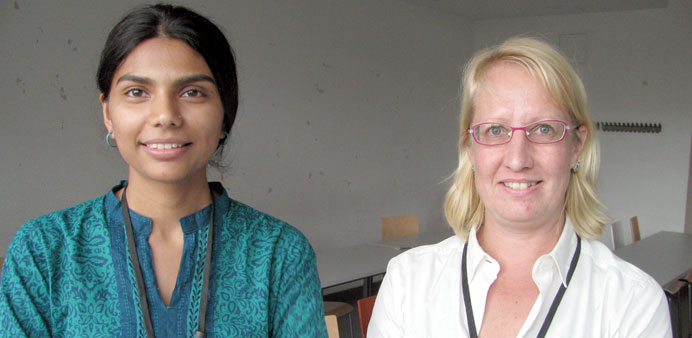Swati Gupta (left) and Tei Laine, two Singapore-based scientists, in a Humboldt University classroom in Berlin at a workshop on deception as a social strategy held recently.
By Jean-Baptiste Piggin
In a crowded room, you would not pick out Swati Gupta and Tei Laine as two of the world’s top experts on how to lie and deceive: they are nice and seem impeccably honest.
Indian-born Gupta actually got her doctorate in England writing a study of politeness. Their secret: they have concluded that our everyday diplomacy demands a certain degree of deception from all of us.
“People deceive all the time. You might say, ‘You look nice today’,” explains Finnish-born Laine. That can help restore confidence to a friend who is not feeling the best. “It’s social glue to make someone feel good,” she says.
The two scientists from Singapore’s Institute of High Performance Computing were in Berlin recently, with Gupta chairing a day-long academic workshop on deception as a social strategy. “Sometimes when you meet other people, you want them to form a good impression of you, so you engage in different types of communication tactics which may or may not include deception,” says Gupta.
“You present yourself in such a way that the belief they have about you is very positive — or negative, depending on your goal.”
Humans use this kind of low-level deception as a means to ends which might include impression management, getting someone else to comply with what you are trying to do, persuading them, negotiating or fitting into a group.
What humans find easy, is, it turns out, extraordinarily difficult to programme into robots, which are not geared to be diplomatic at all. Gupta says software needs to be smarter about presenting information where a hearer could be sensitive.
She gives the example of a robot or avatar designed to teach little children. It must behave like real-life teachers, whose corrective responses have been well studied in academia.
“Whenever a student is wrong, how does the teacher correct them? That has a lot of motivational or de-motivational effect on the student. So a teacher isn’t always truthful about how the student is doing, but is like, ‘You’re doing well. You’ll get there you know.’
“So if you are designing a tutor that is to teach little children, you have to embed aspects of what we call deception in the tutor’s language,” she says. Another example is presenting medical information diplomatically to patients.
“If someone has a life-threatening disease, do you say ‘You’re going to die in two months. On September 3, I predict, you’ll be no more’?” Computers will have to be taught to present information more humanely than that.
Singapore has gathered a cluster of cognitive scientists to study such questions, along the way to developing artificial intelligence that could be built into products of the future such as digital tutors or devices to help care for the elderly.
Gupta and Laine are part of a computational social cognition team that was set up in 2008 with scientists from different backgrounds from around the globe.
To be able to replicate deception, the experts first had to figure out how humans dissemble, ranging from whoppers of deceit down to the teacher’s mundane “You’re doing well.” Among the results was a catalogue of the types of verbal deception.
Like a listing of animal species, it includes the obvious forms of deception, such as fabrications, denials and half-truths, but also types that had not previously been pinned down in the rich psychological literature dealing with deceit, although they have existed for time immemorial in the wild.
Gupta calls one of these new-found species “augmentation,” where you add something gratuitous to the truth to mislead people. “Let’s say John and Mary are colleagues and recently started dating, and went out to dinner. But because it’s the beginning, they don’t want to make the relationship public,” she says.
“Another colleague the next day says to John in a hinting way, ‘I saw that you and Mary were having dinner last night’.”
To forestall the truth, John replies, “Yes, you did; we used it as an opportunity to discuss important project issues.”
Gupta says piling on a true but irrelevant fact like this is the mirror image of a half truth, the type where you omit a key fact.
Their workshop on verbal deception was held at the four-day annual meeting of the Cognitive Science Society, a global group of psychologists, artificial-intelligence experts and philosophers.
“I think lying per se is not evil. It’s the motive behind deception that matters more,” says Gupta.
“We talk to people and say, ‘We’re working on generating deception,’ and everyone is like, ‘Oh you’re doing an evil thing.’
“But if you think of it, even a little deeply, it’s not deception that’s wrong. We deceive all the time in our everyday lives,” she said.
“Our definition of deception is that whenever you don’t present a fact as it is, even if you only manipulate it a little bit, you’re being deceptive. If you go to somebody’s place for dinner and the food tastes horrible, you don’t say it’s horrible. “Then you’re being deceptive. You’re not being honest. Politeness is a form of deception.” – DPA

